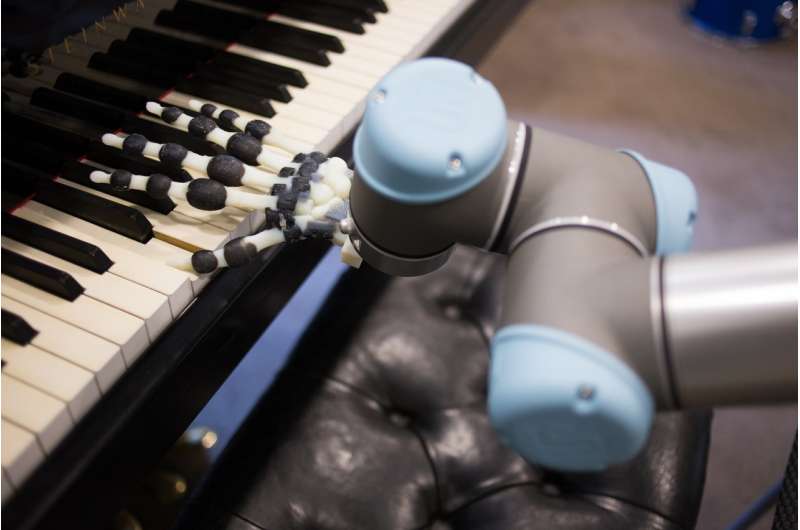3-D-printed robot hand plays the piano

Scientists have developed a 3-D-printed robotic hand which can play simple musical phrases on the piano by just moving its wrist. And while the robot is no virtuoso, it demonstrates just how challenging it is to replicate all the abilities of a human hand, and how much complex movement can still be achieved through design.
The robot hand, developed by researchers at the University of Cambridge, was made by 3-D-printing soft and rigid materials together to replicate of all the bones and ligaments—but not the muscles or tendons—in a human hand. Even though this limited the robot hand's range of motion compared to a human hand, the researchers found that a surprisingly wide range of movement was still possible by relying on the hand's mechanical design.
Using this 'passive' movement—in which the fingers cannot move independently—the robot was able to mimic different styles of piano playing without changing the material or mechanical properties of the hand. The results, reported in the journal Science Robotics, could help inform the design of robots that are capable of more natural movement with minimal energy use.
Complex movement in animals and machines results from the interplay between the brain (or controller), the environment and the mechanical body. The mechanical properties and design of systems are important for intelligent functioning, and help both animals and machines to move in complex ways without expending unnecessary amounts of energy.
"We can use passivity to achieve a wide range of movement in robots: walking, swimming or flying, for example," said Josie Hughes from Cambridge's Department of Engineering, the paper's first author. "Smart mechanical design enables us to achieve the maximum range of movement with minimal control costs: we wanted to see just how much movement we could get with mechanics alone."
Over the past several years, soft components have begun to be integrated into robotics design thanks to advances in 3-D printing techniques, which has allowed researchers to add complexity to these passive systems.
The human hand is incredibly complex, and recreating all of its dexterity and adaptability in a robot is a massive research challenge. Most of today's advanced robots are not capable of manipulation tasks which small children can perform with ease.
"The basic motivation of this project is to understand embodied intelligence, that is, the intelligence in our mechanical body," said Dr. Fumiya Iida, who led the research. "Our bodies consist of smart mechanical designs such as bones, ligaments, and skins that help us behave intelligently even without active brain-led control. By using the state-of-the-art 3-D printing technology to print human-like soft hands, we are now able to explore the importance of physical designs, in isolation from active control, which is impossible to do with human piano players as the brain cannot be 'switched off' like our robot."
"Piano playing is an ideal test for these passive systems, as it's a complex and nuanced challenge requiring a significant range of behaviours in order to achieve different playing styles," said Hughes.
The robot was 'taught' to play by considering how the mechanics, material properties, environment and wrist actuation all affect the dynamic model of the hand. By actuating the wrist, it is possible to choose how the hand interacts with the piano, allowing the embodied intelligence of the hand to determine how it interacts with the environment.
The researchers programmed the robot to play a number of short musical phrases with clipped (staccato) or smooth (legato) notes, achieved through the movement of the wrist. "It's just the basics at this point, but even with this single movement, we can still get quite complex and nuanced behaviour," said Hughes.
Despite the limitations of the robot hand, the researchers say their approach will drive further research into the underlying principles of skeletal dynamics to achieve complex movement tasks, as well as learning where the limitations for passive movement systems lie.
"This approach to mechanical design can change how we build robotics," said Iida. "The fabrication approach allows us to design mechanically intelligent structures in a way that is highly scalable."
"We can extend this research to investigate how we can achieve even more complex manipulation tasks: developing robots which can perform medical procedures or handle fragile objects, for instance," said Hughes. "This approach also reduces the amount of machine learning required to control the hand; by developing mechanical systems with intelligence built in, it makes control much easier for robots to learn."
More information: J.A.E. Hughes el al., "An Anthropomorphic Soft Skeleton Hand Exploiting Conditional Models for Piano Playing," Science Robotics (2018). robotics.sciencemag.org/lookup … /scirobotics.aau3098



















